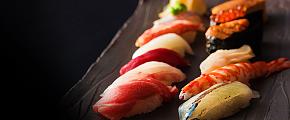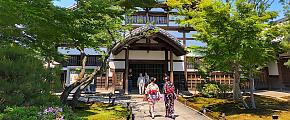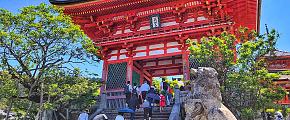A Dummy's Guide to Japanese Onsen
Taking Japanese onsen is a must of every trip to Japan. However, many first time visitors are not quite sure about what they are meant to do or not to do with the Japanese-style bath. To have a better experience, here is a dummy's guide to read before heading to the hot spring!
Best Time and Places to Take Onsen
The best time to take onsen would be from October through May. Winter is especially recommended for there is nothing beats the snow falling on you while you are soaking, which tops the winter activities of Japan amongst all. Besides, that’s when crab is in season for a rich culinary experience after you finish the soak.
Though onsen is ubiquitous in Japan, the best places to try onsen are Hakone, Nagano, Oita and Gunma. Even if you are able to travel far, main tourist cities such as Tokyo and Kyoto also feature great onsens to untie your travel knots.
Simple Steps to Take Onsen

Wash yourself completely undressed as sitting down on a stool under the shower before entering the onsen. The purpose is to keep the hot spring as clean as possible. Soap and shampoo are usually available at no charge, but you are expected to bring your own towel or you can buy one from the ryokan. Dry yourself with the towel after finishing the shower.

Use the towel to cover your body when you walk around, if in a communal onsen. Don't wear swimming suits or sandals, wear the wooden slipper provided instead. It is a traditional custom that everyone goes into onsen together nakedly, so don’t be shy about that. Carefully enter the bath and reveal yourself in a modest manner - never run, splash or jump.

Place the towel on your head or on the side of the bath as you soak. Don't swim, soak your head and use soap in the water. Make sure your voice would not disturb other bathers. If your towel accidentally drops into the bath, take it out quickly and wring it outside the tub. After you finish the bath, dry off your body with the towel and quietly exit. You can shower again before getting dressed.

Eating great Japanese food after an onsen experience is icing on the cake. Ryokan menus may vary from region to season. A hot meal like hot pot that comes with beer and dozens of small courses is the most popular. Just by looking at the way they are gracefully served your eyes will be delighted, let alone your belly is well warmed.
Types of Onsen
Onsen contains outdoor and indoor bath pools, all vary in size. The chemicals and temperature classify onsen into different categories for various health benefits, including simple thermal onsen, sulphur onsen, chloride onsen, carbonated onsen and Iron onsen, to name a few. For the purpose of recovery from travel fatigue or simply getting an onsen experience, simple thermal onsen suits most travelers' basic needs.
There are public bath (mixed gender or gender separation) and private bath available, with the former a good place to blend in with the local, if you are not self-conscious about public nudity. Private hot spring usually costs more, but it'd be family-friendly to use.
Onsen can be easily found in a ryokan (Japanese traditional inn), where you can be a guest to stay overnight or just spend a few hours to take the bath. Alternatives to a ryokan are onsen hotels that also feature Japanese style rooms and western style rooms.
Common Q&A About Onsen
1. What's the average cost of onsen?
It depends on what you want to include in the package. Generally the price per pax ranges from $20 for a quick dip to over $200 for an overnight stay including meals.
2. Does onsen welcome people with tattoos?
No, most public onsens don't accept bathers with tattoos. If your tattoo is small, cover it up with a bandage. Even when you are rejected entering the onsen, respect their rules and try not to break in. If your tattoo is too large to be concealed, one option is to take a private onsen room so no one will know you have tattoos.
3. Can I wear clothes in mixed gender onsen?
Yes, you can wear bathing suits, towel or robe in a mixed gender onsen. Remember that when in a public onsen, you are requested to wear only your birthday suit.
4. How long can I stay in an onsen?
Onsens are usually as hot as above 104F. A long bath is risky of faint or heat stroke. Take breaks by making each bath no more than 15 minutes in the hot water, and don't bathe in an onsen over three times in one day. If you are in the tepid water, then there would be no problem soaking for a longer period.
5. Can I photograph inside?
In most onsens, taking photographs is not allowed due to privacy concerns. There is locker where you can leave your phone and camera before getting in the onsen.
Share this guide that can turn every onsen dummy into onsen expert! Feeling like boiling in the hot spring? My Odyssey Tours knows the best onsen sites in Japan, so just give us a shout out about your tour request - we will be more than happy to craft a Japan tour with wonderful onsen experience for you!
Quick Question
What Our Clients Say About Us
Posts Update
SUBSCRIBE TO WIN A FREE TOUR
Subscribe to our newsletter for a chance to win a free 7-day Morocco tour! And more insider travel news, exclusive offers, and inspiration will be sent straight to your inbox.







